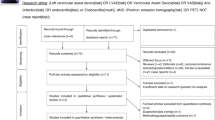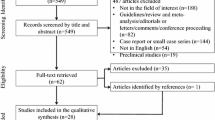Abstract
Background
The usage of left-ventricular-assist device (LVAD) is increasing in patients presenting with advanced heart failure. However, device-related infections are a challenge to recognize and to treat, with an important morbidity and mortality rate. The role of nuclear medicine imaging remains not well established for LVAD infections. The present study compared the accuracy of positron emission tomography/computed tomography with 18F-fludeoxyglucose (18F-FDG PET/CT) and radiolabeled leucocyte scintigraphy for the diagnosis of infections in patients supported with a continuous-flow LVAD.
Methods
From a prospectively maintained database, we retrospectively analyzed the diagnostic performance of radiolabeled leucocyte scintigraphy and 18F-FDG PET/CT in 24 patients who had a LVAD with a suspected device-related infection. Both examinations were routinely performed in all patients. Infection was assessed by the International Society for Heart and Lung Transplantation criteria.
Results
Twenty-four patients were included: 15 had a specific VAD infection (5 cardiac-LVAD and 10 driveline), 6 had a VAD-related infection, while 3 patients had a non-VAD-related infection. Sensitivity, specificity, positive predictive value, negative predictive value, and accuracy were 95.2%, 66.7%, 95.2%, 66.7%, and 91.6%, respectively, for 18F-FDG-PET; and 71.4%, 100%, 100%, 33.3%, and 75%, respectively, for leucocyte scintigraphy. 18F-FDG PET/CT showed significantly higher sensitivity (P = 0.01) than leucocyte scintigraphy.
Conclusion
18F-FDG PET/CT and radiolabeled leucocyte scintigraphy single-photon emission computed tomography carry high performance in the diagnostic of LVAD infections. 18F-FDG PET/CT shows significantly higher sensitivity and could be proposed as first-line nuclear medicine procedure.
Spanish Abstract
Antecedentes
El uso de dispositivos de asistencia ventricular izquierda (DAVI) está incrementando en pacientes con insuficiencia cardiaca avanzada. Sin embargo, las infecciones relacionadas al dispositivo representan un reto diagnóstico y de tratamiento, con una importante tasa de morbilidad y mortalidad. El papel de los estudios de imagen de medicina nuclear en las infecciones de DAVI no se ha establecido claramente. El presente estudio comparó la precisión de la tomografía por emisión de positrones/tomografía computada con 18F-fluorodesoxiglucosa (18F-FDG PET/CT) y la gammagrafía con leucocitos marcados para el diagnóstico de infecciones en pacientes utilizando un DAVI de flujo continuo.
Métodos
Desde una base de datos obtenida de manera prospectiva, analizamos de manera retrospectiva el rendimiento diagnóstico de la gammagrafía de leucocitos marcados y del 18F-FDG PET/CT en 24 pacientes quienes tenían un DAVI con sospecha de infección relacionada al dispositivo. Ambos estudios fueron realizados rutinariamente en todos los pacientes. Se determinó la presencia de infección mediante los criterios de la ISHTL.
Resultados
Se incluyeron veinticuatro pacientes, de los cuales 15 tuvieron una infección específica de DAV (5 con infecciones DAVI, y 10 con infección del driveline), 6 tuvieron una infección relacionada al DAV, y 3 pacientes tuvieron una infección no relacionada al DAV. La sensibilidad, especificidad, valor predictivo positivo, valor predictivo negativo y precisión diagnóstica fueron 95.2%, 66.7%, 95.2%, 66.7% y 91.6%, respectivamente para 18F-FDG PET/CT, y 71.4%, 100%, 100%, 33.3% y 75%, respectivamente para la gammagrafía de leucocitos marcados. El 18F-FDG PET/CT mostró una significativa mayor sensibilidad (p=0.01) que la gammagrafía con leucocitos marcados.
Conclusión
El 18F-FDG PET/CT y la gammagrafía de leucocitos marcados tienen un alto desempeño en el diagnóstico de infecciones de DAVI. El 18F-FDG PET/CT muestra una significativa mayor sensibilidad y podría ser propuesto como el procedimiento de medicina nuclear de primera línea.
Chinese Abstract
背景
左心室辅助装置 (LVAD) 越来越多的应用于重度心力衰竭患者。然而, 设备相关的感染有着重要的发病率和死亡率, 并且对其诊断和治疗均是一项挑战。对于 LVAD 相关感染, 核医学影像可扮演的角色一直没有完善。本研究针对装备有连续流式 LVAD 的感染病人,对比了 18F-FDG PET/CT 造影术和放射性标记白细胞闪烁扫描法对感染诊断的准确性。
方法
从一个前瞻性的数据库, 入选了24名疑似设备感染的 LVAD 病人, 并回顾性的分析了放射性标记白细胞闪烁扫描法和 18F-FDG PET/CT 的诊断表现。所有病人都常规进行了上述两种检查。利用 ISHLT 标准对感染情况进行评估。
结果
在入选的 24 名病人中, 15 名有明确的 VAD 感染 (5 名心脏的 LVAD 和 10 名动力传动系统装置), 6 名有 VAD 相关的感染,另外3名有 VAD 无关的感染。对于 18F-FDG PET/CT 诊断方法,其敏感性,特异性,阳性预测值,阴性预测值和准确率分别为: 95.2%, 66.7%, 95.2%, 66.7%, 和 91.6%; 而对于白细胞闪烁扫描诊断方法, 其敏感性, 特异性, 阳性预测值,阴性预测值和准确率分别为: 71.4%, 100%, 100%, 33.3% 和 75%。相比于白细胞闪烁扫描, 18F-FDG PET/CT 明显展现出较高的敏感性 (p=0.01)。
结论
18F-FDG PET/CT 和白细胞闪烁扫描 SPECT 对于 LVAD 感染的诊断具有很好的表现。18F-FDG PET/CT 展现出较高的敏感性,可以作为核医学的首要检查。
French Abstract
Contexte
L’utilisation du dispositif d’assistance ventriculaire gauche (DAVG) est en utilisation croissante chez les patients avec insuffisance cardiaque avancée. Cependant, les infections liées au dispositif sont un défi à reconnaître et à traiter en raison d’ un taux de morbidité et de mortalité important. Le rôle de l’imagerie de médecine nucléaire n’est pas encore bien établi pour les infections secondaires au DAVG. La présente étude compare la précision de la tomographie par émission de positrons / tomodensitométrie au 18F-fluorodéoxyglucose (18F-FDG TEP/TDM) et la scintigraphie leucocytaire radio-marquée pour le diagnostic d’infections chez des patients porteurs par un DAVG à flux continu.
Méthodes
A partir d’une base de données complétée de manière prospective nous avons analysé rétrospectivement les performances diagnostiques de la scintigraphie leucocytaire radio-marquée et de la TEP / TDM au 18F-FDG chez 24 patients ayant un DAVG avec une infection suspectée liée à l’appareillage. Les deux types d’examens scintigraphiques ont été systématiquement réalisé chez tous les patients. Le diagnostic d’infection fut établi selon les critères ISHLT.
Résultats
Parmi les 24 patients inclus, 15 avaient une infection spécifique de l’appareillage AVG (5 au niveau de la pompe et/ou canule d’insertion myocardique) et 10 au niveau du driveline, 6 avaient une infection indirectement liée à l’appareillage AVG, tandis que 3 patients avaient une infection non liée au DAVG. La sensibilité, la spécificité, la valeur prédictive positive, la valeur prédictive négative et la précision étaient de 95,2%, 66,7%, 95,2%, 66,7% et 91,6%, respectivement, pour le 18F-FDG-PET et 71,4%, 100%, 100%, 33,3 %, et 75%, respectivement, pour la scintigraphie leucocytaire. La TEP / TDM au 18F-FDG a montré une sensitivité significativement plus élevée (p = 0,01) que la scintigraphie leucocytaire.
Conclusion
18F-FDG TEP/TDM et scintigraphie leucocytaire radio-marquée SPECT s’avèrent très efficaces pour le diagnostic des infections à DVAG. La TEP/TDM au 18F-FDG montre une sensibilité significativement plus élevée et pourrait être proposée en tant que la procédure de médecine nucléaire de premier choix.



Similar content being viewed by others
Abbreviations
- LVAD:
-
Left-ventricular-assist device
- VAD:
-
Ventricular-assist device
- DL:
-
Driveline
- CIED:
-
Cardiac-implantable electronic device
- 18F-FDG PET/CT:
-
18F-fludeoxyglucose positron emission tomography/computed tomography
- ISHLT:
-
International Society for Heart and Lung Transplantation
- EANM:
-
European Association of Nuclear Medicine
- HMPAO:
-
Hexamethylpropyleneamine oxime
- INTERMACS:
-
Interagency Registry for Mechanically Assisted Circulatory Support
- MR:
-
Magnetic resonance
- CT:
-
Computed tomography
- SPECT:
-
Single-photon emission computed tomography
- ROC:
-
Receiver operating characteristics
- SUV:
-
Standard uptake value
- MBP:
-
Mediastinal blood pool
- WBC:
-
White blood cell
References
Townsend N, Nichols M, Scarborough P, Rayner M. Cardiovascular disease in Europe—Epidemiological update 2015. Eur Heart J 2015;36:2696-705. https://doi.org/10.1093/eurheartj/ehv428.
Kirklin JK, Naftel DC, Pagani FD, et al. Seventh INTERMACS annual report: 15,000 Patients and counting. J Heart Lung Transplant 2015;34:1495-504. https://doi.org/10.1016/j.healun.2015.10.003.
Habib G, Lancellotti P, Antunes MJ, et al. 2015 ESC Guidelines for the management of infective endocarditis: The Task Force for the Management of Infective Endocarditis of the European Society of Cardiology (ESC). Eur Heart J 2015;36:3075-128. https://doi.org/10.1093/eurheartj/ehv319.
Avramovic N, Dell’Aquila AM, Weckesser M, et al. Metabolic volume performs better than SUVmax in the detection of left ventricular assist device driveline infection. Eur J Nucl Med Mol Imaging 2017. https://doi.org/10.1007/s00259-017-3732-2.
Akin S, Muslem R, Constantinescu AA, et al. 18F-FDG PET/CT in the diagnosis and management of continuous flow left ventricular assist device infections: A case series and review of the literature. ASAIO J 2017. https://doi.org/10.1097/mat.0000000000000552.
Dell’Aquila AM, Mastrobuoni S, Alles S et al. Contributory role of fluorine-fluorodeoxyglucose positron emission tomography/computed tomography in the diagnosis and clinical management of infections in patients supported with a continuous-flow left ventricular assist device. Ann Thorac Surg 2016;101:87-94; discussion 94. https://doi.org/10.1016/j.athoracsur.2015.06.066.
Tlili G, Picard F, Pinaquy JB, Domingues-Dos-Santos P, Bordenave L. The usefulness of FDG PET/CT imaging in suspicion of LVAD infection. J Nucl Cardiol 2014;21:845-8. https://doi.org/10.1007/s12350-014-9872-x.
Juneau D, Golfam M, Hazra S, et al. Positron emission tomography and single-photon emission computed tomography imaging in the diagnosis of cardiac implantable electronic device infection: A systematic review and meta-analysis. Circ Cardiovasc Imaging 2017. https://doi.org/10.1161/circimaging.116.005772.
Litzler PY, Manrique A, Etienne M, et al. Leukocyte SPECT/CT for detecting infection of left-ventricular-assist devices: Preliminary results. J Nucl Med 2010;51:1044-8. https://doi.org/10.2967/jnumed.109.070664.
Erba PA, Sollini M, Conti U, et al. Radiolabelled WBC scintigraphy in the diagnosis workup of patients with suspected device-related infections. JACC Cardiovasc Imaging 2013;6:1075-86. https://doi.org/10.1016/j.jcmg.2013.08.001.
Keidar Z, Pirmisashvili N, Leiderman M, Nitecki S, Israel O. 18F-FDG uptake in noninfected prosthetic vascular grafts: Incidence, patterns, and changes over time. J Nucl Med 2014;55:392-5. https://doi.org/10.2967/jnumed.113.128173.
Hannan MM, Husain S, Mattner F, et al. Working formulation for the standardization of definitions of infections in patients using ventricular assist devices. J Heart Lung Transplant 2011;30:375-84. https://doi.org/10.1016/j.healun.2011.01.717.
de Vries EFJ, Roca M, Jamar F, Israel O, Signore A. Guidelines for the labelling of leucocytes with (99m)Tc-HMPAO. Inflammation/Infection Task Group of the European Association of Nuclear Medicine. Eur J Nucl Med Mol Imaging 2010;37:842-8.
Leisenring W, Alonzo T, Pepe MS. Comparisons of predictive values of binary medical diagnostic tests for paired designs. Biometrics 2000;56(2):345–51.
Salomäki SP, Saraste A, Kemppainen J, et al. 18F-FDG positron emission computed tomography in infective endocarditis. J Nucl Cardiol 2017;24:195–206. https://doi.org/10.1007/s12350-015-0325-y Epub 9 Dec 2015.
Jimenez-Ballvé A, Pérez-Castejon MJ, Delgado-Bolton RC, et al. Assessment of the diagnosis accuracy of 18F-FDG PET/CT in prosthetic infective endocarditis and cardiac implantable electronic device infection: Comparison of different interpretation criteria. Eur J Nucl Med Mol Imaging 2016;43:2401-12.
Rouzet F, Chequer R, Benali K, et al. Respective performance of 18F-FDG PET and radiolabeled leukocyte scintigraphy for the diagnosis of prosthetic valve endocarditis. J Nucl Med 2014;55:1980-5. https://doi.org/10.2967/jnumed.114.141895 Epub 13 Nov 2014.
Lauridsen TK, Iversen KK, Ihlemann N, et al. Clinical utility of (18)F-FDG positron emission tomography/computed tomography scan vs. (99m)Tc-HMPAO white blood cell single-photon emission computed tomography in extra-cardiac work-up of infective endocarditis. Int J Cardiovasc Imaging 2017;33:751-60. https://doi.org/10.1007/s10554-016-1047-1.
Disclosure
The authors declare no conflict of interest.
Author information
Authors and Affiliations
Corresponding author
Additional information
The authors of this article have provided a PowerPoint file, available for download at SpringerLink, which summarises the contents of the paper and is free for re-use at meetings and presentations. Search for the article DOI on SpringerLink.com.
JNC thanks Erick Alexanderson MD, Carlos Guitar MD, and Diego Vences MD, UNAM, Mexico, for providing the Spanish abstract; Haipeng Tang MS, Zhixin Jiang MD, and Weihua Zhou PhD, for providing the Chinese abstract; and Jean-Luc Urbain, MD, PhD, CPE, Past President CANM, Chief Nuclear Medicine, Lebanon VAMC, PA, for providing the French abstract.
Electronic supplementary material
Below is the link to the electronic supplementary material.
Rights and permissions
About this article
Cite this article
de Vaugelade, C., Mesguich, C., Nubret, K. et al. Infections in patients using ventricular-assist devices: Comparison of the diagnostic performance of 18F-FDG PET/CT scan and leucocyte-labeled scintigraphy. J. Nucl. Cardiol. 26, 42–55 (2019). https://doi.org/10.1007/s12350-018-1323-7
Received:
Accepted:
Published:
Issue Date:
DOI: https://doi.org/10.1007/s12350-018-1323-7




